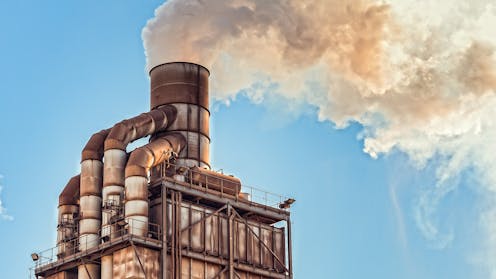Taxes and caps on carbon work differently but calibrating them poses the same challenge
Explaining how carbon taxes and cap-and-trade systems work is simpler than figuring out how high those taxes and caps should be.

Virtually everything most people on earth do these days involves, either directly or indirectly, the combustion of oil, gas and coal. Burning these fossil fuels is generating carbon emissions, which accumulate in the atmosphere, contributing to global warming.
Since climate change could become catastrophic, economists argue that fossil fuel producers and companies that emit massive amounts of carbon should have to pay a fee or a tax. Economists also say that the people harmed by these emissions – basically, everyone – should be compensated for this harm.
My research on environmental regulation and the design of international environmental agreements looks at the two main ways to address this underlying problem: carbon taxes and cap-and-trade systems. As William Nordhaus, one of the two 2018 Nobel laureates in economics, has explained, the main idea behind both of these approaches to putting a price on carbon is to give people and companies an incentive to alter their behavior in ways that reduce greenhouse gas emissions and slow the pace of climate change.
Carbon taxes
A carbon tax makes fossil fuels more expensive, in turn encouraging utilities, businesses and consumers to use less of them. At the same time, it makes alternatives, such as wind and solar power more competitive – encouraging their use. When designed and implemented properly, carbon taxes raise the price of carbon-intensive goods and lower the prices of non-carbon-intensive goods.
Finland was the first country to establish a carbon tax in 1990. As of October 2018, about 25 governments – including national, state, provincial and local jurisdictions – were levying them, according to the World Bank.
The revenue carbon taxes generate are either distributed as dividends to the public or spent on a government priority, sometimes tied to climate change. An example of this would be supporting renewable energy innovation.
Cap-and-trade systems
With cap-and-trade systems, governments establish quotas that limit how much carbon dioxide and other greenhouse gases can be emitted over the course of a year or another time period. The authorities also issue permits or allowances that authorize the emissions, which can be bought and sold.
These permits are scarce by design. That creates demand for them and the opportunity to set up exchanges where buyers and sellers can agree on the price of the permits and then trade them.
The European Union, several Canadian provinces and U.S. states are some of the best examples of governments using these systems. Established in 2005, the European Union’s Emissions Trading System operates in 31 countries.
The same challenge
The track records to date of both carbon taxes and cap-and-trade systems indicate that they are curbing carbon emissions and encouraging investment in renewable energy, energy efficiency and other technologies that can shrink carbon footprints.
But three things remain unclear: by what amount are they reducing emissions, whether they are operating more efficiently than other options and who is gaining and losing the most from carbon pricing programs.
All told, carbon taxation and trading raised US$33 billion in 2017 across 45 countries and another 25 states, provinces and other jurisdictions around the world, according to the World Bank’s latest carbon pricing overview.
Both kinds of systems are easier to discuss in theory than to put into practice because of all the uncertainties associated with climate change.
That is, governments that levy carbon taxes and set caps on greenhouse gas emissions must move forward without knowing what might be the precise level at which taxes and quotas will spur the requisite changes in energy consumption and business practices.
Amitrajeet A. Batabyal has received research funding from the United States Department of Agriculture, the Giannini Foundation for Agricultural Economics and the Charles Koch Foundation.
Read These Next
TikTok fears point to larger problem: Poor media literacy in the social media age
If the US wants to protect young people from misinformation and foreign influence, focusing on TikTok…
How Trump is using courtroom machinations to his political advantage
The number of prospective jurors saying they can’t be fair to Trump because of who he is does not…
Wild turkey numbers are falling in some parts of the US – the main reason may be habitat loss
Wild turkeys were overhunted across the US through the early 1900s, but made a strong comeback. Now,…




